My fly boxes
{{start}}
The number of fly boxes you carry is obviously one of personal choice. One difficulty you may encounter when you are setting up your fly boxes is which flies you should include, and how many flies you should carry in your fly box or boxes. The last thing you want to be doing is standing on the bank of a river madly pulling flies out to find a fly you know is there . . .somewhere, but it isn’t where you expected to find it or you fly box or boxes are so crowded with flies that the one you are desperately looking for is hidden away . . . somewhere.
{{end}}
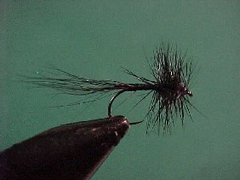
{{+1}}Black spinner{{-1}}
{{start}}
The term spinner is generally used only in the context of referring to a small number of Mayflies including Black, Red and Orange Spinners when they are both on the water and in the air. The following Spinner is a generic representation for members of the “Leptophlebiidae” family of Mayflies and the various Highland Duns & Spinners, which are members of the “Oniscigastridae” family. Hatches generally occurs between the months of October and March.{{end}}
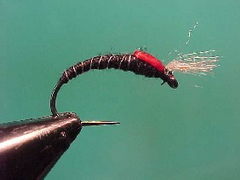
{{+1}}Chatto’s black alpine buzzer{{-1}}
{{start}}
This is the second in the series of three versions of the same fly. This first in the series is the bloodworm version. which is the original colour of the pupa as it emerges from the slime on the lake bottom. Over a short period of time the bloodworm changes to a dark colour with varying amounts of red present as the transformation occurs. As it reaches the surface the dark colour mellows and the pupa assumes a grey or olive colour similar to its terrestrial colour.{{end}}
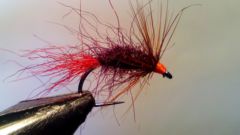
{{+1}}Claret carrot{{-1}}
{{start}}
Based on the design of the carrot fly this version is particularly appealing to fish feeding on emerging Mayfly in Tasmania's central and western lake.{{end}}
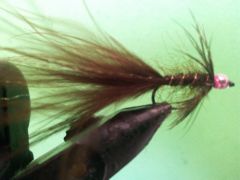
{{+1}}Metalic pink TBH brown woolly bugger{{-1}}
{{start}}
This is a variation of a bead head woolly bugger that has worked very well for me in Lake Eucumbene and Tantangara Reservoir on brown trout and on Lake Maroon for bass.{{end}}

{{+1}}Humungus – black and gold{{-1}}
{{start}}
The tie of my fly is very close to David Downey's fusion of those two flies which he describes as perhaps the best still water fly in the world. I use it as a top dropper attractor and for that reason use a brass rather than a tungsten bead. Particularly in water that is a little discoloured I am confident this fly brings a lot of fish to my team.{{end}}
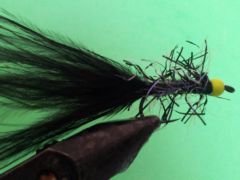
{{+1}}Todd’s Vampire (variant){{-1}}
{{start}}
Based in Maple Ridge, B.C. Todd Oishi designed his "leach" (Vampires are also a blood sucker hence the name) fly with a tail of black rabbit fur or black marabou and with Vampire Vippy as the body. I have not been able to find any Vampire Vippy and tie my Vampires with UV straggle fritz.{{end}}
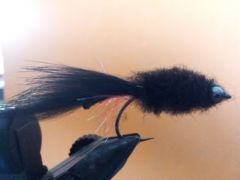
{{+1}}Destroyer – Chatto’s variant{{-1}}
{{start}}
My variant does not include the shroud of mara wool tips around the zonker tail. I have left that off because for me the currents around the body of the fly produce more movement in the tail when it is not shrouded. I like hot spots on flies and accordingly have added a hot spot of red Wapsi palmer chenille under the tail. For my deeper water flies, as many other users have done, I use bead chain eyes rather than the unweighted plastic chain eyes as on the original.{{end}}
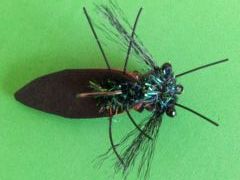
{{+1}}Foam cicada – Chatto’s ‘black prince’{{-1}}
{{start}}
This fly sits well into the surface film like the natural and has a very realistic profile when viewed from below. I have made it smaller than the natural on purpose as flies tied as big as the natural are frustratingly cumbersome to cast on #8 weight outfits that are my preference of the target species mentioned above. The fly lands with a good audible fish attracting 'plop' and with its outstretched wings that are only about half as long as the natural still wiggle with the slightest movement in a very enticing way.{{end}}

{{+1}}UV cruncher{{-1}}
{{start}}
More of a class of fly than a fly in itself because you will find UV crunchers tied a all sorts of colours from black right through to dun colours and pale olives. I like this particular tie because it incorporates peacock herl which is one of my favourite fly tying materials.{{end}}

{{+1}}PTN variant{{-1}}
{{start}}
This variation of Frank Sawyers pheasant Tail Nymph takes into account the shorter herl on pheasant tails that dominate the market these days and to include the substitution of peacock or coloured dubbing in the thorax and the addition of legs.{{end}}













